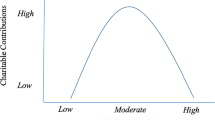Abstract
This study examined two distinct theoretical explanations for the effect of attire on aiding behavior. The reinforcing value of attire itself predicted that well-dressed persons would always receive more assistance than poorly dressed persons. The reinforcing value of perceived similarity predicted that similar persons would receive more assistance than dissimilar persons. Female confederates (N=17) who were well-dressed or poorly dressed approached males and females in an airport or bus station asking for a dime to complete a telephone call. Well-dressed confederates received more money at the airport; poorly dressed confederates received more money at the bus station. These results were interpreted as support for the similarity hypothesis.
Similar content being viewed by others
References
Berscheid, E., & Walster, E. Physical attractiveness. In Berkowitz, L. (Ed.),Advances in expermental social psychology. New York: Academic Press, 1974.
Bickman, L. Clothes make the person.Psychology Today 1974,4 49–51.
Burgoon, J.K. & Saine, T.The unspoken dialogue. Boston: Houghton Mifflin, 1978.
Chaikin, A.L., Derlega, V.J., Yoder, J., & Phillips, D. The effects of appearance on compliance.Journal of Social Psychology 1974,92 199–200.
Crassweller, P., Gordon, M.A., Tedford, W.H., Jr. An experimental investigation of hitchhiking.Journal of Psychology 1972,82 43–47.
Darley, J.M., & Cooper, J. The “clean for Gene” phenomenon: The effect of students' appearance on political campaigning.Journal of Applied Social Psychology 1972,2 24–33.
Deutsch, M., & Krauss, R.M.Theories in social psychology. New York: Basic Books, 1965.
Harris, M.B., & Bays, G. Altruism and sex roles.Psychological Reports 1973,32 1002.
Harrison, R.P.Beyond words. Englewood Cliffs, N.J.: Prentice Hall, 1974.
Hastorf, A.H., Schneider, D.J., & Polefka, J.Person perception. Menio Park, California: Addison-Wesley, 1970.
Knapp, M.L.Nonverbal communication in human interaction. (2nd ed.) New York: Holt, Rinehart & Winston, 1978.
Leathers, D.G.Nonverbal communication systems. Boston: Allyn & Bacon, 1976.
Raymond, B.J. & Unger, R.K. Effect of deviant and conventional attire on cooperation.Proceedings of the American Psychological Association 1971,6 357–358.
Rosenfeld, L.B. & Plax, T.G. Clothing as communication.Journal of Communication 1977,27 24–31.
Schiavo, R.S., Sherlock, B., & Wicklund, G. Effect of attire on obtaining directions.Psychological Reports 1974,34 245–246.
Suedfeld, P., Bochner, S., & Matas, C. Petitioner's attire and petition signing by peace demonstrators.Journal of Applied Social Psychology 1971,1 278–283.
Suedfeld, P., Bochner, S. & Wnek, D. Helper-sufferer similarity and a specific request for help: Bystander intervention during a peace demonstration.Journal of Applied Social Psychology 1972,2 17–23.
Author information
Authors and Affiliations
Additional information
An earlier version of this paper was competitively selected to be presented to the communication theory interest group at the Central States Communication Association convention in St. Louis, Missouri, April 5–7, 1979.
Rights and permissions
About this article
Cite this article
Hensley, W.E. The effects of attire, location, and sex on aiding behavior: A similarity explanation. J Nonverbal Behav 6, 3–11 (1981). https://doi.org/10.1007/BF00987932
Issue Date:
DOI: https://doi.org/10.1007/BF00987932




